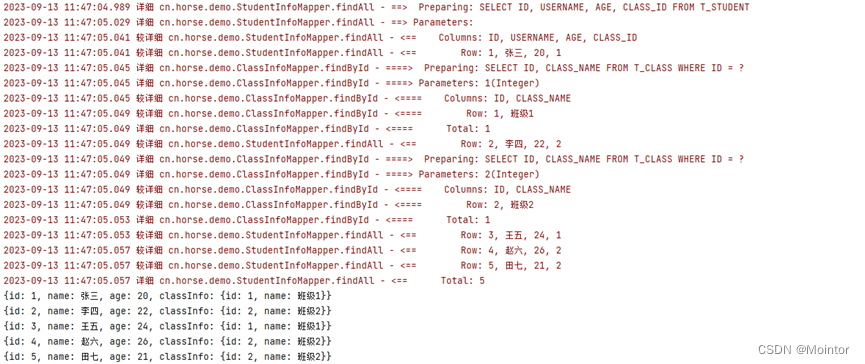我们之前介绍了使用XML配置复杂结果映射,上一篇中我们介绍了在Mybatis映射器中使用@Results定义结果映射,将查询出的数据库表中的每条数据映射成对象;本篇我们在映射器中使用@Results定义复杂结果映射,解决一对一关系中复杂的数据映射问题。
如果您对XML配置复杂结果映射、@Results注解不太了解,建议您先进行了解后再阅读本篇,可以参考:
Mybatis 复杂结果映射(ResultMap) - 一对一关系映射![]() https://blog.csdn.net/m1729339749/article/details/132548654Mybatis 映射器中使用普通结果映射(@Results)
https://blog.csdn.net/m1729339749/article/details/132548654Mybatis 映射器中使用普通结果映射(@Results)![]() https://blog.csdn.net/m1729339749/article/details/132865075
https://blog.csdn.net/m1729339749/article/details/132865075
一、数据准备
这里我们直接使用脚本初始化数据库中的数据
-- 如果数据库不存在则创建数据库
CREATE DATABASE IF NOT EXISTS demo DEFAULT CHARSET utf8;
-- 切换数据库
USE demo;
-- 创建班级表
CREATE TABLE IF NOT EXISTS T_CLASS(
ID INT PRIMARY KEY,
CLASS_NAME VARCHAR(32) NOT NULL
);
-- 创建学生表
CREATE TABLE IF NOT EXISTS T_STUDENT(
ID INT PRIMARY KEY,
USERNAME VARCHAR(32) NOT NULL,
AGE INT NOT NULL,
CLASS_ID INT NOT NULL
);
-- 插入班级数据
INSERT INTO T_CLASS(ID, CLASS_NAME)
VALUES(1, '班级1'),(2, '班级2');
-- 插入学生数据
INSERT INTO T_STUDENT(ID, USERNAME, AGE, CLASS_ID)
VALUES(1, '张三', 20, 1),(2, '李四', 22, 2),(3, '王五', 24, 1),(4, '赵六', 26, 2),(5, '田七', 21, 2);
创建了一个名称为demo的数据库;并在库里创建了名称为T_CLASS的班级表和名称为T_STUDENT的学生表,并向表中插入了数据
二、创建实体类
在cn.horse.demo下创建ClassInfo、StudentInfo类
ClassInfo类:
package cn.horse.demo;
public class ClassInfo {
private String id;
private String name;
@Override
public String toString() {
StringBuilder result = new StringBuilder();
result.append('{');
result.append("id: " + this.id);
result.append(", ");
result.append("name: " + this.name);
result.append('}');
return result.toString();
}
}
StudentInfo类:
package cn.horse.demo;
public class StudentInfo {
private int id;
private String name;
private int age;
private ClassInfo classInfo;
@Override
public String toString() {
StringBuilder result = new StringBuilder();
result.append('{');
result.append("id: " + this.id);
result.append(", ");
result.append("name: " + this.name);
result.append(", ");
result.append("age: " + this.age);
result.append(", ");
result.append("classInfo: " + this.classInfo.toString());
result.append('}');
return result.toString();
}
}
三、创建映射器
在cn.horse.demo下创建ClassInfoMapper、StudentInfoMapper接口
ClassInfoMapper接口:
package cn.horse.demo;
import org.apache.ibatis.annotations.Result;
import org.apache.ibatis.annotations.Results;
import org.apache.ibatis.annotations.Select;
public interface ClassInfoMapper {
@Results(id = "classInfoMap", value = {
@Result(column = "ID", property = "id"),
@Result(column = "CLASS_NAME", property = "name")
})
@Select({"SELECT ID, CLASS_NAME FROM T_CLASS WHERE ID = #{id}"})
ClassInfo findById(Integer id);
}
StudentInfoMapper类:
package cn.horse.demo;
import org.apache.ibatis.annotations.One;
import org.apache.ibatis.annotations.Result;
import org.apache.ibatis.annotations.Results;
import org.apache.ibatis.annotations.Select;
import java.util.List;
public interface StudentInfoMapper {
@Results(id = "studentInfoMap", value = {
@Result(column = "ID", property = "id"),
@Result(column = "USERNAME", property = "name"),
@Result(column = "AGE", property = "age"),
@Result(one = @One(select = "cn.horse.demo.ClassInfoMapper.findById"),
column = "CLASS_ID", property = "classInfo")
})
@Select({"SELECT ID, USERNAME, AGE, CLASS_ID FROM T_STUDENT"})
List<StudentInfo> findAll();
}
@One:类似于association标签,用于解决一对一的关联关系的数据映射问题;通过使用select指定查询方法执行的结果作为映射的数据,查询方法传递的参数使用column属性指定(此属性值来源于数据库表查询字段,示例中我们使用了数据库查询结果中的CLASS_ID字段作为参数进行查询学生的班级数据)。
四、引入配置文件
在resources下新建mybatis-config.xml配置文件,并引入StudentInfoMapper、ClassInfoMapper映射器。
<?xml version="1.0" encoding="UTF-8" ?>
<!DOCTYPE configuration
PUBLIC "-//mybatis.org//DTD Config 3.0//EN"
"http://mybatis.org/dtd/mybatis-3-config.dtd">
<configuration>
<settings>
<setting name="logImpl" value="JDK_LOGGING"/>
</settings>
<environments default="development">
<environment id="development">
<transactionManager type="JDBC"/>
<dataSource type="POOLED">
<property name="driver" value="org.gjt.mm.mysql.Driver"/>
<property name="url" value="jdbc:mysql://localhost:3306/demo?useUnicode=true&useSSL=false&characterEncoding=utf8"/>
<property name="username" value="root"/>
<property name="password" value="horse"/>
</dataSource>
</environment>
</environments>
<mappers>
<mapper class="cn.horse.demo.StudentInfoMapper" />
<mapper class="cn.horse.demo.ClassInfoMapper" />
</mappers>
</configuration>
这里我们使用mapper引入映射器,这里分别引入了StudentInfoMapper映射器和ClassInfoMapper映射器。
五、启动程序
1、会话工具类
在cn.horse.demo包下新建SqlSessionUtils工具类
package cn.horse.demo;
import org.apache.ibatis.session.SqlSession;
import org.apache.ibatis.session.SqlSessionFactory;
import org.apache.ibatis.session.SqlSessionFactoryBuilder;
import java.io.InputStream;
import java.util.Objects;
public class SqlSessionUtils {
private static final SqlSessionFactory sqlSessionFactory;
static {
// 读取mybatis配置文件
InputStream inputStream = ClassLoader.getSystemClassLoader().getResourceAsStream("mybatis-config.xml");
// 根据配置创建SqlSession工厂
sqlSessionFactory = new SqlSessionFactoryBuilder()
.build(inputStream);
}
/**
* 开启会话
* @return
*/
public static SqlSession openSession() {
return sqlSessionFactory.openSession();
}
/**
* 关闭会话
* @param sqlSession
*/
public static void closeSession(SqlSession sqlSession) {
if(Objects.nonNull(sqlSession)) {
sqlSession.close();
}
}
}
2、JDK 日志系统配置
在resources的目录下新建logging.properties配置文件
handlers=java.util.logging.ConsoleHandler
.level=INFO
cn.horse.demo.ClassInfoMapper.level=FINER
cn.horse.demo.StudentInfoMapper.level=FINER
java.util.logging.ConsoleHandler.level=ALL
java.util.logging.ConsoleHandler.formatter=java.util.logging.SimpleFormatter
java.util.logging.SimpleFormatter.format=%1$tY-%1$tm-%1$td %1$tT.%1$tL %4$s %3$s - %5$s%6$s%n
在cn.horse.demo下创建JdkLogConfig类
JdkLogConfig类:
package cn.horse.demo;
import java.io.IOException;
import java.io.InputStream;
import java.util.logging.LogManager;
public class JdkLogConfig {
public JdkLogConfig() {
try {
InputStream inputStream = ClassLoader.getSystemClassLoader().getResourceAsStream("logging.properties");
LogManager.getLogManager().readConfiguration(inputStream);
} catch (IOException e) {
throw new RuntimeException(e);
}
}
}
3、启动程序
package cn.horse.demo;
import org.apache.ibatis.session.SqlSession;
import java.util.List;
import java.util.function.Consumer;
public class Main {
public static void main(String[] args) {
// 引入JDK日志配置
System.setProperty("java.util.logging.config.class", "cn.horse.demo.JdkLogConfig");
// 查询
execute((StudentInfoMapper studentInfoMapper) -> {
List<StudentInfo> studentInfoList = studentInfoMapper.findAll();
for (StudentInfo studentInfo: studentInfoList) {
System.out.println(studentInfo);
}
});
}
private static void execute(Consumer<StudentInfoMapper> function) {
SqlSession sqlSession = null;
try {
sqlSession = SqlSessionUtils.openSession();
function.accept(sqlSession.getMapper(StudentInfoMapper.class));
sqlSession.commit();
} finally {
SqlSessionUtils.closeSession(sqlSession);
}
}
}
execute方法用于执行操作,方法中使用sqlSession.getMapper方法获取映射器对象,然后将映射器对象具体的执行操作委托给了Consumer对象。
执行的结果如下:
























 2万+
2万+











 被折叠的 条评论
为什么被折叠?
被折叠的 条评论
为什么被折叠?








